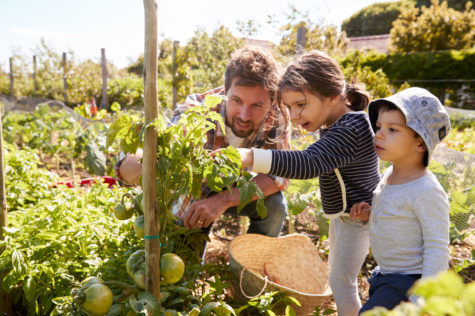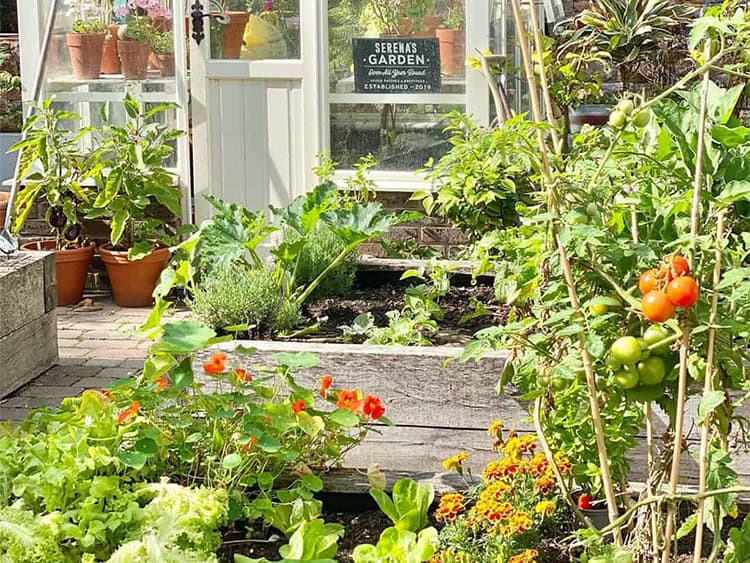Are you wondering when to trellis your squash plants? Squash belong to a group of fruits that grow on large plants. Trellising these plants might seem like a great idea, but is it even possible?
If you want to know more about growing squash on a trellis, read on!

Credit: Shutterstock
When to trellis squash
Squash can be trellised as soon as it starts to grow shoots. Gently weave the shoots through the trellis and secure them with some string or soft plant ties. As your plant grows, continue to train it by weaving the new growth through the trellis.
You can remove the ties as soon as your plant has grown enough tendrils to hold itself to the trellis. If you see any wayward growth, gently weave it onto the trellis or do some light pruning.
Type of trellis for squash plants
Squash plants need a firmer, sturdier trellis than most other climbers due to their size and weight. The fruits can also be quite heavy and will need to be supported. It is usually cheaper to build your own trellis from scrap wood or metal.
The support poles of your trellis should be spaced between 1.5 to 2 metres apart (5-6 feet). Make sure they’re properly anchored into the ground to avoid collapse from the heavy plant. Once your supports are erected, create a framework with wire or more poles for your vines to cling to.
The framework material should be spaced at least 12.7 centimetres (5 inches) apart for your vines to climb on. Once fruits start to develop, you can use old tights to support them.
Types of squash that can be grown on a trellis
Just about any type of squash can be trellised as long as it has a vining tendency. If you try to force a bush variety onto a trellis, it just won’t work no matter how hard you try. The best way to figure out what variety of squash you have is to read the back of the seed packet.
If you’re specifically looking for a squash variety that can be trellised, try the following:
- Delicata squash
- Acorn squash
- Zucchini
- Yellow summer squash
Some varieties of squash such as butternut and turban can be trellised but don’t usually fare that well due to the weight of their fruits.
The benefits of growing squash vertically
Growing squash on a trellis might seem like quite a hassle but there are quite a few benefits that go along with this method such as:
Saving on space
Some squash plants get huge and will take up a lot of space when left to grow on the ground. If you don’t have a lot of garden space, training a squash plant to climb is a great way to free up space for other plants. You can also grow more squash in less space.

Credit: Shutterstock
Protection against pests and diseases
By lifting your plant and fruit up off the ground, you make it more difficult for pests and diseases to infect your crop. There will be no muddy, damp areas for pests to hide in and more airflow between the leaves that will prevent fungus and other diseases by keeping your plant aerated and mud-free.
Protection against animals
By lifting the fruits off the ground, you can more easily protect them against animals and other small critters on the ground.
Cleaner, easier to harvest crop
Growing squash vertically prevents your plant from getting covered in mud. The fruits will also stay pristine and it will be much easier to find and pick off the vine.
No yellow spot
When squash lies on the ground, the fruit will develop a yellow spot where it touches the ground. This happens due to lack of sunlight and constant contact with the cold, often wet ground.

Credit: Shutterstock
Contain your crop
Squash plants tend to get quite big and will take over your whole garden if you allow them to. Training them to climb makes it much easier to contain and control any wild growth. This plant also looks stunning on a trellis.
How to grow squash on a trellis
At this point, you might be quite keen to get started, but how exactly is squash grown on a trellis? Don’t fret, it’s quite simple really. Let’s take a look.
Squash isn’t a natural climber so you will need to help it out a little. If allowed it will preferably grow horizontally along the ground due to the weight of the plant. You can train your plant to climb by gently weaving the vines through the trellis framework.
If they won’t stay by themselves, tie them to the trellis by using a piece of string or plant clips.

A figure of eight knot helps to secure plants against a trellis; Credit: Shutterstock
You will need to keep an eye on the secured vines to make sure the string doesn’t cut into them as they grow. It is best to secure them very loosely to make room for some growth as the vine thickens.
Your squash plant should eventually secure itself to the trellis. Once that happens, you can remove any string or clips and reuse them on new growth. Be careful when training your plant, however, young shoots are very delicate and may get broken while weaving them through the trellis.
Maintaining squash trellises
Trellising squash will require a bit more maintenance than the horizontal plants. You will need to keep an eye on your tied vines to make sure they don’t get strangled. During summer, these plants grow very quickly which means you will need to check any ties every few days.
You will also need to train any new growth to climb. If your trellis is getting too crowded, you might need to prune away any new growth. Once your plant starts to fruit, you will need to look after and support the fruit.
Squash fruits are quite heavy. Depending on the type of squash, you might need to give them support to prevent gravity from picking them early. Use old tights, net or similar material to gently tie them to the frame.

Growing squash on a trellis is possible with a little extra support. Credit: Shutterstock
Squash plants grown on a trellis also need a lot of care. Due to training the vines upward, you’re preventing them from forming more roots to support the plant. For this reason, you will need to water and fertilise your squash plant regularly to keep it growing and healthy.
Keep in mind that squash plants can get massive. You will need to accommodate the size of the plant with your trellis. If you don’t have that much space, stick to the smaller types of squash. Generally, the smaller the squash fruit, the shorter the vine will be. That means that pumpkins may climb all the way up a giant tree! So beware where you grow your squash.
Problems with trellising squash
Squash plants aren’t climbers by choice. You will need to spend quite a bit of time helping your vines to find their way up a trellis. Also, keep in mind that not all types of squash can be trellised.
If you’ve decided to trellis your plant, you will need to make sure the structure is big enough to accommodate the size of the mature plant. As a rule of thumb, the bigger the fruit, the longer the vine will be.

Credit: Shutterstock
You will also need to consider the fruit. Squash fruits can get very big depending on the type of plant. You’ll need to take this into account and give them some support. Without support, there is a risk of the fruit falling to the ground early.
Squash plants on a trellis are also a lot needier than those grown horizontally. You will need to keep up with watering and feeding your squash to keep it healthy enough to bear fruit.
FAQs
Should squash be grown on a trellis?
There is no set rule that forces you to grow squash on a trellis. If you have enough space, you can leave this plant to creep along the ground. Trellising squash will, however, free up a lot of space in small gardens and prevent the plant from taking over your garden.
Can you leave squash on the vine too long?
It is possible but unlikely. When squash is ripe you will notice that the stem connecting the fruit to the plant will turn brown and wither away.
You can also test the toughness of the skin to know when your squash is ready. A mature squash fruit has very tough skin.
How far apart should squash be planted?
Vining varieties need to be planted 30.5 to 38 centimetres (12-15 inches) apart in rows that are 1.8 to 4 metres (6-12 feet) apart.
Bush varieties need to be spaced 38 to 51 centimetres (15-20 inches) apart in rows that are 1.2 to 1.8 metres (4-6 feet) apart.

Save this pin for later






